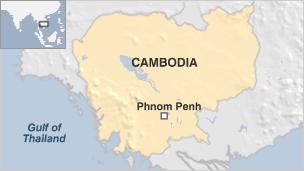Hundreds killed in Cambodian festival stampede
- Published
Daylight revealed the aftermath of the Cambodia stampede
At least 345 people have been killed in a stampede during festival celebrations in the Cambodian capital, Phnom Penh, Prime Minister Hun Sen has said.
Huge crowds had gathered on a small island for the final day of the Water Festival, one of the main events of the year in Cambodia.
The stampede took place on a bridge, which eyewitnesses said had become overcrowded.
Hundreds more people were injured in the crush.

Hun Sen described the stampede as the "biggest tragedy" to hit Cambodia since the mass killings carried out by the Khmer Rouge regime in the 1970s.
He said he had ordered an investigation and declared a national day of mourning for later in the week. He ordered all government ministries to fly the nation's flag at half-mast.
Government spokesman Khieu Kanharith told AFP news agency that more than 400 people had been injured.
"Most of the deaths were as a result of suffocation and internal injuries," he said.
Authorities had estimated that more than two million people would attend the three-day festival.
Panic broke out after a concert on Diamond Island, which followed a boat race on the Tonle Sap river regarded as a highlight of the festivities.
Sean Ngu, an Australian who was visiting family and friends in Cambodia, told the BBC too many people had been on the bridge.
He said some of the victims were electrocuted.
"There were too many people on the bridge and then both ends were pushing," he said.
"This caused a sudden panic. The pushing caused those in the middle to fall to the ground, then [get] crushed.
"Panic started and at least 50 people jumped in the river. People tried to climb on to the bridge, grabbing and pulling [electric] cables which came loose and electrical shock caused more deaths."
Witnesses spoke of bodies littering the area.
Calmette Hospital, Phnom Penh's main medical facility, was filled with dead bodies as well as the injured, some of whom had to be treated in hallways.
- Published23 November 2010